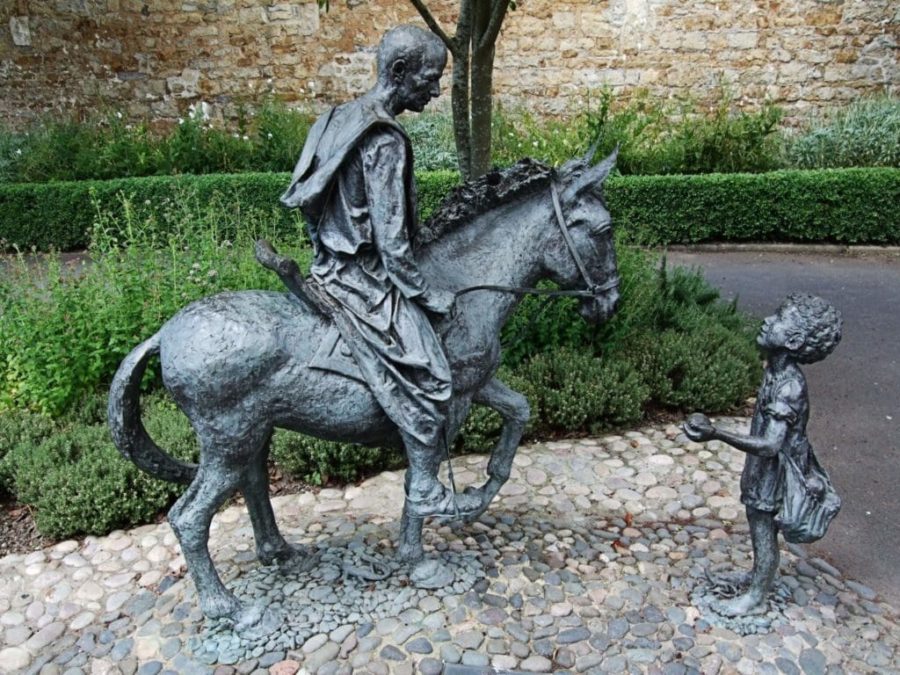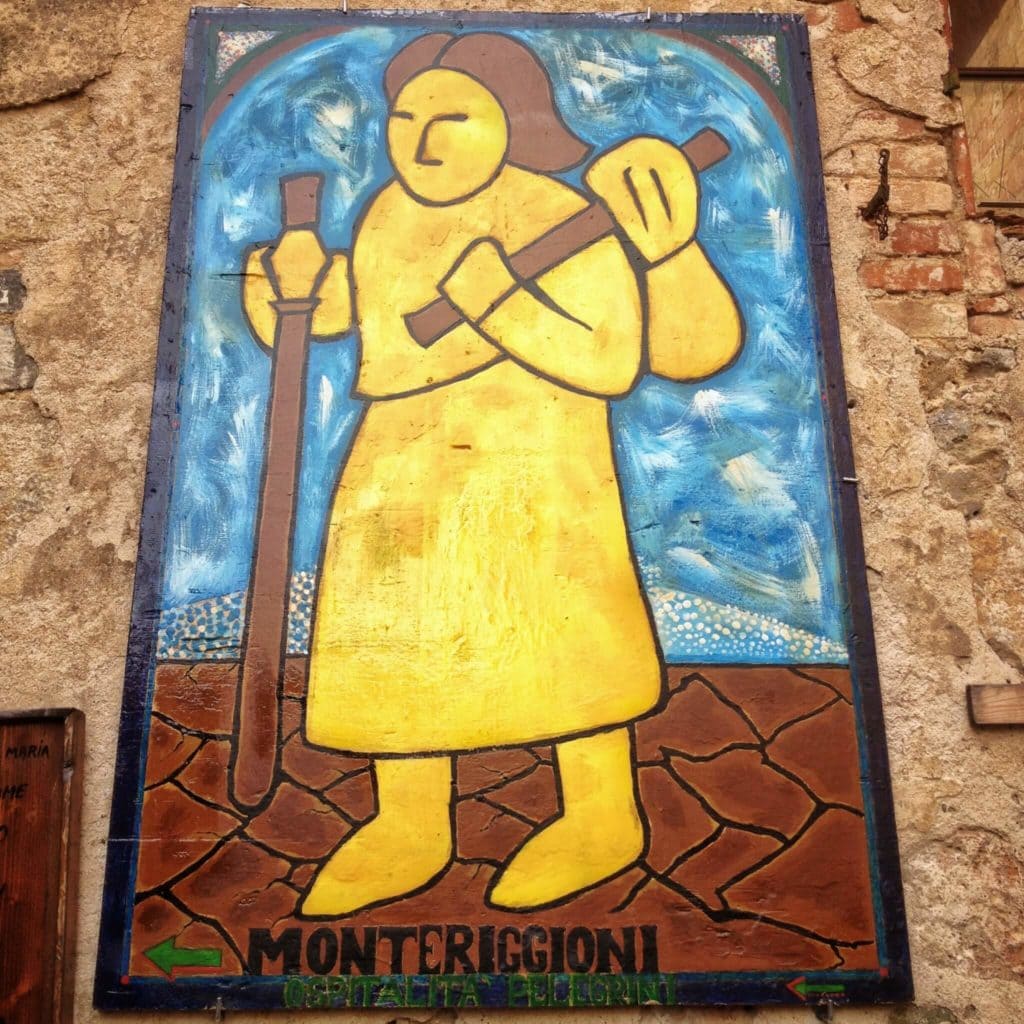Via Francigena in Tuscany represented for many years in the past, a route for pilgrims from Canterbury to Rome. Today it keeps being a popular walking track by those who love hiking through nature among artistic and historic treasure.
During my life, I have seen hundreds of walkers doing the pilgrimage along the itinerary of Via Francigena in Tuscany. Some of them do it for spiritual reasons, some others just because they love to trek along a very ancient route. Generally, you recognize them because they are walking along the streets carrying a backpack, helping themselves with walking sticks from which they often hang the Saint James shell (that is a scallop). This means that probably the pilgrims have already done the Camino de Santiago.
The Via Francigena in Tuscany goes from the Cisa Pass in the north up to Radicofani, in the province of Siena, in the south.
Right inside this post I am going to tell you a little bit about the history of this ancient route
A short brief of the history of Via Francigena in Tuscany
The story of Sigeric Archibishop of Canterbury
The origin of Via Francigena is dated back to 990ac at the time of Sigerico Archbishop of Canterbury. He started a religious pilgrimage to Rome to receive the Pallium from the Pope. During the way back to Canterbury, he wrote a travel journal where the eighty stops between Rome and Calais in France were noted. This would have become the Sigeric Itinerary and later Via Francigena.
Sigeric took 79 days to travel along the itinerary of 1600 km (995 miles), with an average of 20 km (12 miles) per day.
Sigeric the Serious Archibishop of Canterbury – Photo Credits: Jim Linwood
The Longobards
Actually, the original root goes back to the Longobards in the VI Century. They were interested into the conquest of the area that went from Lunigiana (the north of the town of Luni) and the ancient Tuscia (corresponding to the nowadays Tuscany). To reach this region, they crossed the Monte Bardone, between the village of Berceto and Pontremoli. Today this route is called Cisa Pass. This new path was at a safe distance from the routes controlled by their enemies, the Byzantines.
From Franks and Carolingians until the present
The Via Francigena became a major exchange route with the advent of the Franks and the Carolingians because the Via Francigena was linked to Lucca and to Altopascio crossing the Arno River. The Via Francigena itinerary continued up to the Elsa Valley and Siena. Once arrived in Siena the Via Francigena is connected to the Via Cassia that was an Imperial road at the time of the Roman Empire.
Following this direction, it crossed the Val d’Arbia and Val d’Orcia to finally reach Rome.
The Via Francigena passed through the most important residential centers of that time, even sacred places of the Christian world. How we cannot mention the beautiful Cathedral of Lucca, where the Holy Face is showed, and the Hospital of Santa Maria della Scala in Siena, where precious reliquaries are displayed.
By the time, Via Francigena became more and more an important route. Connecting the Mediterranean Sea to the Northern Sea, people used the road to merchandise, contributing to the development of the commerce in Europe.
In 1994, the Itinerary of Via Francigena has been declared Cultural Heritage of Europe on par with the most famous Camino de Santiago.
The ancient pilgrim
The pilgrim in past was recognizable by its clothes. The traditional clothes consisted in a confortable dress to ease the walk, a hat with large brim to protect the head by the sun, wind and rain, and a cloak against the cold.
The ancient pilgrim accustomed himself to bring a sack containing just the few useful things for the journey. They had a walking stick that was useful to walk and also in case of animal attack. Another typical pilgrim object was an empty pumpkin, used as water bottle, and fixed to the walking steak.
At the moment of the departure for the pilgrimage there were two rituals to do: the dressing and the walking steak ritual.
The official logo of the pilgrim as signage of the Via Francigena pathway
The Ritual for the Pilgrim Dressing
“Accipe hanc peram habitum peregrinationis tuae ut bene castigatus et emendatus pervenire merearis ad limina sancti Iacobi, quo pergere cupis, et peracto itinere tuo ad nos incolumis con gaudio revertaris, ipso praestante qui vivit et regnat Deus in omnia saecula saeculorum.”
“Get this bag, attribute of your pilgrimage that, purified and amended, you hurry to arrive at the foot of St. James where you desire to arrive and, completed your trip, come back to us healthy and except with great joy, so if you want God lives and reigns for ever and ever.”
The ritual of the Walking Steak
“Accipe hunc baculum, sustentacionem itineris ac laboris ad viam peregrinationis tuae ut devincere valeas omnes catervas inimici et pervenire securus ad limina sancti Iacobi et peracto cursu tuo ad non revertaris cum gaudio, ipso annuente qui vivit et regnat Deus in omnia saecula saeculorum.”
“Get this walking stick to support your journey and in the struggle on the road of your pilgrimage so it will serve to beat anyone will want to of evil and makes you get quiet at the foot St. James and made your trip, you I can come back to us with great joy, with the help of God himself, who lives and reigns forever and ever.”
Do not miss our post with the map and stages of the itinerary of Via Francigena in Tuscany, full of helpful tips if you are planning this wonderful experience.



WOW! This is so fascinating! I would love to trek this route some day. 😀 I can’t get enough of history, and this is right up my alley.
Hello Becky 🙂 Thank you for your message. If everything will be fine, next year I will trek this route. The Via Francigena pass through my city, and I always desired but even procrastinated, such a good experience of walk that leads to Rome, walking along ancient trails, and watching the marvelous and differents scenery.
Is not yet popular like the Camino of Santiago, but is getting year by year more popular, and pilgrims are getting even more numerous. Maybe next year we will meet along the path, greeting each other with the typical expression “Buon cammino! / Good walk!”
Wonderfull landscape, nice villages, a world entire to discover. Thanks for your information!
Hi Jose, thanks for reading. Consider that we talked only about a small part of this Camino…but this ancient road was used by pilgrims and merchants to go from Canterbury to Rome! 🙂